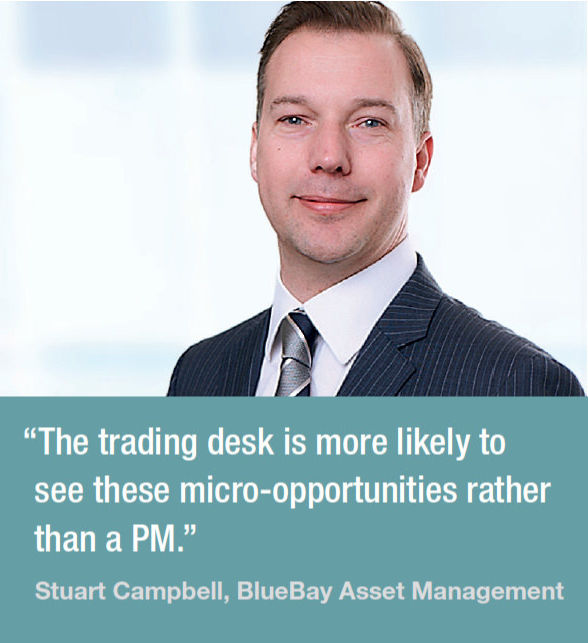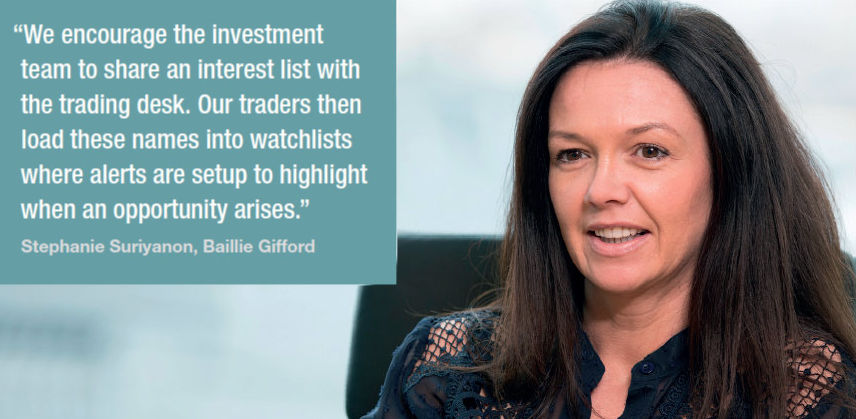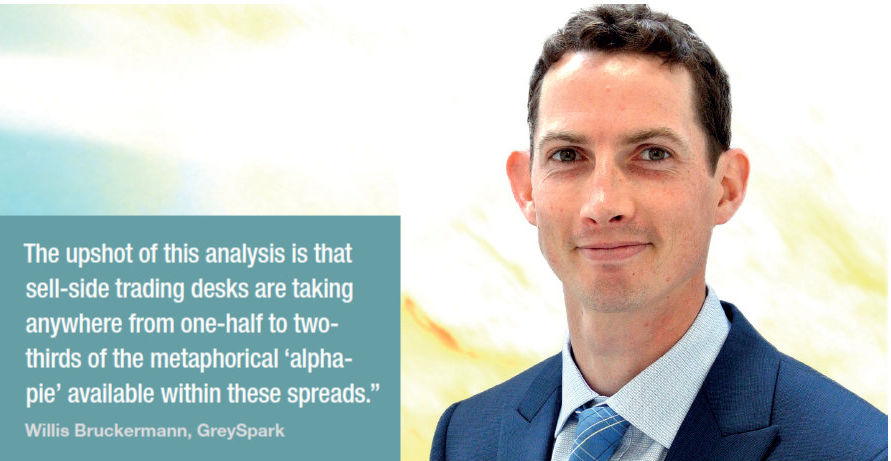Setting up your desk correctly can help to boost returns for funds and clients.
When an opportunity arises for a fund to improve its returns, it is incumbent upon the portfolio manager to act on their investors’ behalf. However, spotting and acting upon these opportunities requires lean, fast and accurate interactions between the portfolio managers and traders.
Working out how to capture that information and to process it ahead of the competition can really help a client or fund’s performance.
 “It’s got to be quick, because if the bank has approached you with a block, they may want to make two to four other phone calls – but that’s information leakage, if you are fortunate enough to have been the first phone call,” says Stuart Campbell, head of trading at BlueBay Asset Management. “This is a five- or 10-minute turnaround time for block trades. Can the PM take these? Are they in the office? The traders will literally be chasing around the office trying to find a person, because they know that if they are not quick to respond the next phone call is going onto the next firm.”
“It’s got to be quick, because if the bank has approached you with a block, they may want to make two to four other phone calls – but that’s information leakage, if you are fortunate enough to have been the first phone call,” says Stuart Campbell, head of trading at BlueBay Asset Management. “This is a five- or 10-minute turnaround time for block trades. Can the PM take these? Are they in the office? The traders will literally be chasing around the office trying to find a person, because they know that if they are not quick to respond the next phone call is going onto the next firm.”
In the fixed income markets, setting up trading desks to be responsive to these micro-opportunities is becoming more vital. The relative importance of such opportunities is increasing, as a result of low yields, which are challenging the typical alpha generation model for long-only funds. Consequently, identifying best practice can help a head of desk to significantly improve efficiency of responsiveness.
Generating opportunities
The first element is to be proactive in the market in order to create potential. One element that supports this is price making. Buy-side firms are increasingly price makers as a response to the reduction of sell-side market making activity, and through engagement on all-to-all trading platforms. By taking a proposal to the dealers has shifted the dynamic between the buy- and sell side in the price formation process.
 “[When approached with a price] it is more acceptable for the sell side to make a call and come back to you, as opposed to ‘Here is the bid right on the wire’,” said Sonali Pier, executive vice president at PIMCO, speaking at the Fixed Income Leaders Summit in Philadelphia, on 19 June 2019. “Why that first look [on the price] is so important is because you are able to be the price setter.”
“[When approached with a price] it is more acceptable for the sell side to make a call and come back to you, as opposed to ‘Here is the bid right on the wire’,” said Sonali Pier, executive vice president at PIMCO, speaking at the Fixed Income Leaders Summit in Philadelphia, on 19 June 2019. “Why that first look [on the price] is so important is because you are able to be the price setter.”
Having that information creates a number of advantages, she observed, not only in the trading process but also in setting investment goals.
“[That] informs us better from a portfolio management perspective; with all of that data and information, the analytics area are able to further enhance it to look for micro-opportunities for investment,” she said.
Opportunities also occur naturally due to arbitrage between other price makers. Some fund managers will cross bonds through a portfolio for an instant profit, buying from one broker and selling to another at a more advantageous price, then running that across whichever funds can participate based on their mandates.
Due to the poor liquidity levels, certain axes become strained, or dealers want to cover shorts at aggressive levels, so there can be ‘panic covering’. Although not common, when they happen these situations should still be seized.
“More commonly we try and take advantage of opportunities around the primary market; bonds might be weaker on the back of some supply coming, and therefore we look to pick up the secondary paper rather than the primary paper,” says Campbell. “There has been a gravitation towards trading and new issuance. There are generally still a few basis points on offer, and for the first several days there is generally liquidity to get out of your position, so that’s become a larger part of the micro-opportunity set that you are targeting.”
A sharp eye
Having established where opportunities are more likely, it is then key for the asset manager to make it straightforward for traders to identify the right points at which to alert a PM, and for the PM to have the chance to respond.
 Stephanie Suriyanon, senior trader at Baillie Gifford, says, “We encourage the investment team to share an interest list with the trading desk. Our traders then load these names into watchlists where alerts are setup to highlight when an opportunity arises.”
Stephanie Suriyanon, senior trader at Baillie Gifford, says, “We encourage the investment team to share an interest list with the trading desk. Our traders then load these names into watchlists where alerts are setup to highlight when an opportunity arises.”
The risk of false positives is high, say traders, and that is worsened if either the PMs or traders are using data which is misleading.
“Levels on the screens are sometimes not a very good starting point,” Campbell notes.
To overcome this issue, technology providers are trying to support single views of the market which can be shared across desks and provide analytics to pinpoint when a real opportunity occurs.
“We are in the process of implementing an execution management system (EMS), which we believe will automate part of this process and enhance our capture of axes, all-to-all enquiries and inventory through relevant application programming interfaces (APIs),” says Suriyanon.
Having the infrastructure to build prices effectively internally can also be valuable in order to support Pier’s observation about creating opportunities through price making.
In a February 2019 report, analyst GreySpark assessed publicly-available US TRACE and MarketAxess TRAX data which found that broker-dealers capture a far larger share of the full bid-ask spread for all instruments than price-taking, buy-side bond traders.
 “Indeed, the ability to price instruments independently results in many inter-dealer trades showing a negative bid-ask spread, while both dealer-to-client and C2C trades – wherein one client is price-making and the other is price-taking – result in far higher average spreads and a lower share of trades with negative spreads. The upshot of this analysis is that sell-side trading desks are taking anywhere from one-half to two-thirds of the metaphorical ‘alpha-pie’ available within these spreads,” wrote analyst Willis Bruckermann.
“Indeed, the ability to price instruments independently results in many inter-dealer trades showing a negative bid-ask spread, while both dealer-to-client and C2C trades – wherein one client is price-making and the other is price-taking – result in far higher average spreads and a lower share of trades with negative spreads. The upshot of this analysis is that sell-side trading desks are taking anywhere from one-half to two-thirds of the metaphorical ‘alpha-pie’ available within these spreads,” wrote analyst Willis Bruckermann.
GreySpark argued that using better pricing technology would help asset managers in reducing this lost alpha. Composite third-party prices have become popular over the past year as a way to help build prices, while some buy-side firms such as AXA Investment Managers have built their own pricing tools. It is also possible to buy third-party systems to support this.
 Ivan Mihov, sales director at fixed income EMS provider, Axe Trading, says his firm has tapped sell-side technology to help buy-side price making, and that reduces the need for trader and PM to discuss where a price should be or how it has been derived.
Ivan Mihov, sales director at fixed income EMS provider, Axe Trading, says his firm has tapped sell-side technology to help buy-side price making, and that reduces the need for trader and PM to discuss where a price should be or how it has been derived.
“The way we approach the subject is through the centralised pricing engine,” he says. “We service market-makers, with the ability to create a price, post it on the market and invite electronic trading flow on the back of that. The pricing engine doesn’t have to be only for market making, you can use it as a bond price calculator and the price that you are deriving from that engine can be your internal composite price.”
Having an internal composite price that both the PM and the trader agree on with a predetermined methodology helps to the engagement, he observes.
“Creating orders with the respective limits reduces discussion around price formation, derivation method and whether it can be traded on,” Mihov says.
However, ultimately it is the trading desk that should be relied upon to hunt down investment opportunities, Campbell argues, as they are likely to have the focus on the market as well as an understanding of the realistic price level, based on skill as well as technology.
“The trading desk is more likely to see these micro-opportunities rather than a PM,” he says. “It depends on the shop that you are talking to where the PM might be fully engrossed in trying to maintain every axe, every run that is coming in. But given the volume coming through now, it’s trickier for them to spot and if you are a PM shouting to a trader that you think there is an opportunity, the most likely response from the trader is going to be, don’t trust your screen.”
©The DESK 2019
©Markets Media Europe 2025
























